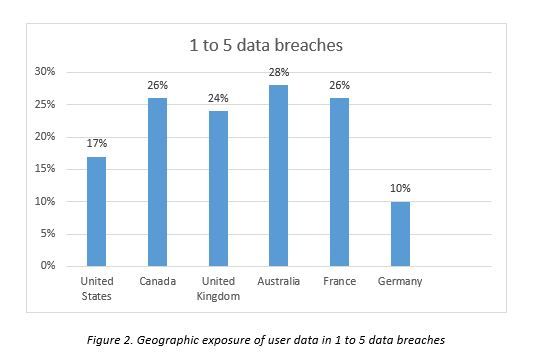From Data Breach to Data Pandemic: Watching Your Back in Today’s Online World

The exposure and compromise of sensitive personal data dominated the data security scene in 2021, with publicly reported data breaches rising 68% from 2020 to an all-time high, according to the ITRC.
This surge reflects the extent of human error in the online world, as well as the passiveness of users who largely remain lax about their own security despite the increase of threats brought by digitalization across the globe.
An analysis of Bitdefender’s Digital Identity Protection (DIP) telemetry over the past 12 months reveals the harsh state of data exposure among users in two categories: voluntary disclosure of personal data online and the prevalence of users’ private information in data breaches.
Internet users are actively contributing to their digital footprint
The trail of information shared when you go online constitutes your digital footprint. The record of this online activity includes two main types of digital footprints: active and passive.
Your active digital footprint builds up automatically whenever you voluntarily submit information, including posting or uploading media files on social media. Your passive digital footprint, however, is created without your knowledge. It includes your IP address and browsing history, among others.
Last year’s figures raise serious privacy concerns, with an average of 26 data entry points per user exposed online.
Nearly four in 10 users have between two and nine data entry points that make up their active digital footprints. More alarmingly, six in 10 users have over 10 data traces left intentionally behind on the web.
According to our data, the most exposed user data traces are URLs (26%), jobs (21%) and home or physical addresses (20%).
Here’s a list of the average number of data entry points willingly exposed by users online:
- 2 email addresses
- 3 data entry points for home or physical address
- 3 data entry points suggesting their educational background
- 3 users IDs
- 5 data entry points exposing job background and career information
- 6 URLs linked to various social media accounts and platforms
Although every netizen has a digital footprint, it’s become crucial for users to learn about the negative effects and how they can manage their online persona to stay safe.
A digital trail created via reckless use of online platforms and excessive sharing on social media can damage your reputation, ruining potential employment opportunities or future relationships, and making it easier for criminals to scam or defraud you.
Data breach exposure in numbers
More than half of users have fallen victim to data breaches, with an average of five data breaches per user, according to the latest figures from the Digital Identity Protection community. Specifically, 22% of users have their personal information exposed in one to five data breaches, with a further 14% exposed in six to 10 data security incidents, and 19% in 11 or more data breaches.
23% of American users were impacted by over 10 data breaches, according to our geographic analysis. The UK holds the second spot with 19%, followed by Canada and Australia with 15%, Germany with 10% and France with 8% (see fig. 1).

Australians tipped the scales with the highest 1 to 5 data breach exposure rate of 28%, followed by Canada and France with 26% each, the UK with 24%, the US with 17% and Germany with 10% (see fig. 2).

The UK and Australia are the top contenders in the six to 10 data breach exposure category with 16% each (see fig. 3). The two countries are followed by Canada with 14%, the US and Germany with 13% each and France with 12%.

A season of pretenders
Data analysis of online user impersonations flagged by the Bitdefender Digital Identity Protection community shows a chilling outcome, with an average of three impersonations per user globally.
However, a geographic breakdown puts the US on the map with an average of four impersonation attempts. Canada, the UK, and Australia with an average of three, Germany with two and France with one (see fig. 4).

How Bitdefender’s Digital Identity Protection service can help manage your footprint and increase safety online
It’s nearly impossible to remember how much information you’ve shared online over the years. Bitdefender Digital Identity Protection is your dedicated digital first aid kit to help you discover the extent of your digital footprint and make more privacy-focused decisions that will keep you, your money, and your data safe in the long run.
The service scours the web for your old accounts using only the data you provide in the onboarding process (email address and phone number), allowing you to analyze and manage your digital self and reduce the amount of data that can put your reputation and livelihood at risk.
Users can find and delete old accounts, immediately respond to data breaches and sniff out social media impersonators with real-time alerts whenever someone creates an account using your data.
Each revealed data entry, privacy risk or data breach revealed comes with easy one-click action items that allow you to close off any security risks by immediately changing compromised passwords and making the necessary privacy adjustment on all of your accounts.
Stay Safe!
tags
Author
Alina is a history buff passionate about cybersecurity and anything sci-fi, advocating Bitdefender technologies and solutions. She spends most of her time between her two feline friends and traveling.
View all postsRight now Top posts
Start Cyber Resilience and Don’t Be an April Fool This Spring and Beyond
April 01, 2024
Spam trends of the week: Cybercrooks phish for QuickBooks, American Express and banking accounts
November 28, 2023
3 in 5 travel-themed spam emails are scams, Bitdefender Antispam Lab warns
August 10, 2023
FOLLOW US ON SOCIAL MEDIA
You might also like
Bookmarks








